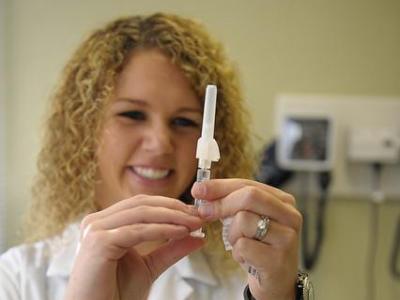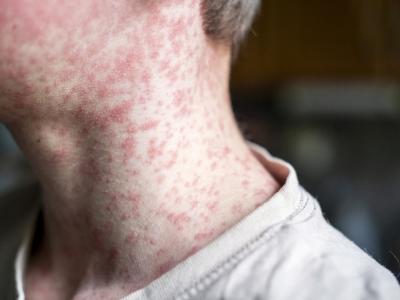DRC launches vaccine campaign in new Ebola outbreak area
Following the reappearance of Ebola in the Democratic Republic of the Congo's (DRC's) Equateur province, the country today launched an rVSV-EBOV vaccine campaign, tapping an initial shipment of 200 doses, the World Health Organization (WHO) African regional office said today.
The campaign will use a "ring vaccination" strategy, targeting contacts and contact of contacts and also include health providers and other frontline workers.
The outbreak total in the province's capital city Mbandaka stands at two fatal cases. So far, 233 contacts have been identified for monitoring.
Outbreak responders have also set up a 20-bed Ebola treatment center in the city. A completed analysis of a sample from the first confirmed case conducted by the DRC's National Institute for Biomedical Research shows that the outbreak was triggered by a new spillover from the host or animal reservoir. The outbreak marks the DRC's 14th since 1976, including three from Equateur Province since 2018.
Apr 27 WHO African regional office statement
Third dose of mRNA vaccines highly protective against Omicron deaths
A new study published in Clinical Infectious Diseases shows a third dose of Pfizer or Moderna mRNA vaccines were 89.6% to 78.8% protective against deaths during the Omicron surge compared to no vaccination.
The study adds to a growing body of literature which suggests booster does can raise antibody levels to fight circulating strains, despite being formulated to fight the original strain of SARS-CoV-2.
To conduct the study, researchers matched 221,267 Pfizer third-dose recipients and 187,507 Moderna third-dose recipients to equal numbers of primary series vaccinated people and unvaccinated people, all seen at Veterans Health Administration medical facilities. The groups were followed between Dec 1, 2021 and Mar 12, 2022.
Compared to those who completed just a primary series, third-dose Pfizer recipients were 30.1% (95% confidence interval [CI], 26.2 to 33.7), 61.4% (95% CI, 55.0 to 67.1), and 78.8% (95% CI, 67.9 to 87.5) more protected against documented infection, hospitalization, and death, respectively. Compared to unvaccinated people, third-dose recipients were 47.8% (95% CI, 45.2 to 50.3), 81.8% (95% CI, 79.2 to 84.2), and 89.6% (95% CI, 85.0 to 93.6) more protected against documented infection, hospitalization, and death.
Similar trends were seen in Moderna third-dose recipients, who were 61.9% (95% CI, 59.4 to 64.4), 87.9% (95% CI, 85.3 to 90.2), and 91.4% (95% CI, 86.4 to 95.6) more protected against documented infection, hospitalization, and death, respectively, compared to the unvaccinated.
"We observed that all measured COVID-19 infection outcomes occurred less frequently in persons who received the third dose of vaccine compared to individuals who completed the primary series," the authors concluded. "These observations are consistent with differences in predicted pathways of vaccine-mediated immunity against Omicron variant: heightened antibody evasion facilitates mild illness, but an unimpaired cellular immune response maintains protection against severe infection."
Apr 27 Clin Infect Dis study
WHO: Worldwide measles cases up 79% in 2022
The WHO today is warning of a perfect storm for measles resurgence, due to a 79% increase in the first 2 months of 2022 and pandemic-related disruptions in routine childhood vaccination.
In addition to pandemic-related disruptions, the WHO said millions of displaced people due to conflicts and crises in Ukraine, Ethiopia, Somalia and Afghanistan, could also result in a significant increase in measles cases.
A total of 17,338 measles cases were reported worldwide in January and February 2022, compared to 9,665 during the first two months of 2021. In 2020, the WHO said, 23 million children missed out on basic childhood vaccines through routine health services, the highest number since 2009 and 3.7 million more than in 2019.
Somalia, Yemen, Afghanistan, Nigeria, and Ethiopia report the highest number of cases in 2022. In the last year, 21 large outbreaks have been reported globally.
"Measles is more than a dangerous and potentially deadly disease. It is also an early indication that there are gaps in our global immunization coverage, gaps vulnerable children cannot afford," said Catherine Russell, UNICEF Executive Director, in a press release. "It is encouraging that people in many communities are beginning to feel protected enough from COVID-19 to return to more social activities. But doing so in places where children are not receiving routine vaccination creates the perfect storm for the spread of a disease like measles."
Apr 27 WHO press release
Canada among countries probing acute hepatitis cases in children
Canadian health officials said yesterday that unexplained hepatitis cases have been identified in Canada and are under investigation, according to multiple Canadian media reports, which cited responses to queries from the Public Health Agency of Canada (PHAC).
The reports did not say how many cases are under investigation or what provinces the affected children are from.
So far, at least 14 countries have reported cases. Japan and Romania are among the most recent countries to report potentially related cases. United Kingdom health officials, who first raised the alarm earlier this month, said yesterday that an adenovirus connection is still being considered and that data show a marked increase in adenovirus circulation, especially in kids ages 1 to 4.
Apr 26 Toronto Star story
Apr 26 CIDRAP News scan
USDA announces $263 million for avian flu outbreak response
The US Department of Agriculture (USDA) today announced that Agriculture Secretary Tom Vilsack has approved the transfer of nearly $263 million from the Commodity Credit Corporation (CCC) to the Animal and Plant Health Inspection Service (APHIS) to continue its work with state and local partners to quickly identify and manage ongoing highly pathogenic avian influenza outbreaks.
The outbreaks involve the Eurasian H5N1 strain and so far have hit poultry flocks in 29 states, leading to the loss of 33.3 million birds. Vilsack approved $130 million in emergency funding in March to address the outbreaks. The CCC was established in the 1930s to stabilize, support, and protect farm income and prices.
In related developments today, APHIS reported 42 more H5N1 detections in wild birds, raising the total to 899. Most of the latest detections were birds found dead, including several raptors, in Minnesota. They also included four more from Wyoming.
Apr 27 USDA press release
USDA APHIS wild bird avian influenza page











